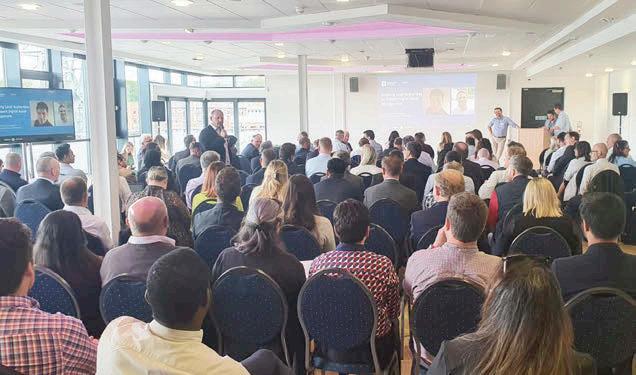
3 minute read
DIGITAL CONNECTIVITY INFRASTRUCTURE ACCELERATOR (DCIA) UPDATE
from UK5G. Issue 11
and expense of starting from scratch each time. Critically, however, they should only ever be treated as a framework to start conversations. Eynon offered this guidance: “Know your context, know who you’re dealing with, know the challenges on them and what’s going to be possible.”
Dunn highlighted that although Eynon’s work is in very different regions, there are some common learnings that others can build from, such as a recognition that standardised templates can only ever be templates: they start off conversations but there will always be unique factors that come into play for specific sites, and authorities need to be empowered and capable to adjust the templates to work for them.
Advertisement
PROGRESS IS BEING MADE in the project to help local authorities manage sites that can be used to expand the mobile networks. The goal of the programme is to provide organisations with the tools and skills to digitally manage public sector assets through testing of different approaches.
At a face-to-face event in Bristol in June, more than 100 people from regional and local authorities, the telecoms industry, government and other stakeholders caught up on developments.
A panel that included four mobile network operators was chaired by Gareth Elliott from Mobile UK. It was followed by a crossgovernment panel that included Building Digital UK, the DfT, the Barrier Busting Task Force and the National Underground Asset Register, chaired by Nick Wiggin from DCMS.
“It was a fantastic occasion,” said Wiggin, “a genuine sense of the industry and government coming together to drive forward digital connectivity. The face-to-face networking elements were incredibly well-received and the main piece of feedback was to do more in-person events like this, to drive collaboration.”
That collaboration was demonstrated by the presentations. Gary Littledyke from Wessex and Lynne Wilson from West Berkshire explained that the key to success in asset data collection is thinking strategically about what data will provide the greatest value, rather than just collating everything available. They explained how contextualising data can improve the process for infrastructure providers, and there was a real sense that now is the time to develop these asset management platforms.
Nicola Scullard from West Sussex talked through her consortium’s approach to mapping process workflows and measuring the improvements. She observed that the team who looks after an asset is not likely to be the one that makes a decision on using it. West Sussex has therefore decided to develop a bespoke product to deliver the requirements of all the councils who would eventually use it, and is working to ensure processes are built into the product from the start. Scullard said the benefits of the pilot will be measured in terms of making things quicker: “how we can remove steps, streamline and make deployments more quickly”.
A key to working together and reducing the process overhead is having standardised commercial models for access to assets, and this subject was co-presented by Sarah Eynon of Scottish Futures Trust Infralink and Lucy Dunn from the West London Alliance.
It was clear from their presentation that standardisation of contract templates can help to streamline processes and avoid the time
There is an irony in the term “digital asset management”. Traditionally this means the management of assets that are in themselves digital – artwork, logos, intellectual property and the like. When Antony Corfield from the West of England Combined Authority and Vasilis Papakonstantinou, from West Midlands 5G talked about enabling local authorities to support digital asset management they were discussing the digital management of physical assets, typically bus stops and street lights. Corfield reflected on how the industry could help local authorities. “There needs to be recognition that there are constraints in the public sector,” he observed, adding that an openness to dialogue means all sides can achieve what they need more quickly.
Both presenters agreed that it would be valuable for industry to consider how to create more win-win situations for local authorities, especially in supporting those who may not have the connectivity know-how.
Turning to central government, Papakonstantinou highlighted the value of events such as this to disseminate information to leaders, to ensure they are equipped with relevant insights and empowered to build their own digital strategies. He added: “It would be great to see digital champions everywhere. If central government had a way of monitoring this, it could identify gaps and intervene to try to direct places to take the successful actions we’ve seen elsewhere.”
A more in-depth write-up of the DCIA Dissemination Event can be found on the uk5g.org website.
If you would like to get involved in the DCIA programme, please email dcia-info@dcms.gov.uk










